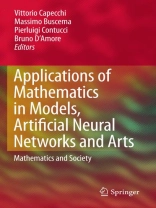The book shows a very original organization addressing in a non traditional way, but with a systematic approach, to who has an interest in using mathematics in the social sciences.
The book is divided in four parts: (a) a historical part, written by Vittorio Capecchi which helps us understand the changes in the relationship between mathematics and sociology by analyzing the mathematical models of Paul F. Lazarsfeld, the model of simulation and artificial societies, models of artificial neural network and considering all the changes in scientific paradigms considered; (b) a part coordinated by Pier Luigi Contucci on mathematical models that consider the relationship between the mathematical models that come from physics and linguistics to arrive at the study of society and those which are born within sociology and economics; (c) a part coordinated by Massimo Buscema analyzing models of artificial neural networks; (d) a part coordinated by Bruno D’Amore which considers the relationship between mathematics and art.
The title of the book ‚Mathematics and Society‘ was chosen because the mathematical applications exposed in the book allow you to address two major issues: (a) the general theme of technological innovation and quality of life (among the essays are on display mathematical applications to the problems of combating pollution and crime, applications to mathematical problems of immigration, mathematical applications to the problems of medical diagnosis, etc.) (b) the general theme of technical innovation and creativity, for example the art and mathematics section which connects to the theme of creative cities.
The book is very original because it is not addressed only to those who are passionate about mathematical applications in social science but also to those who, in different societies, are: (a) involved in technological innovation to improve the quality of life; (b) involved in the wider distribution of technologicalinnovation in different areas of creativity (as in the project ‚Creative Cities Network‘ of UNESCO).
Inhaltsverzeichnis
Mathematics and Models.- Mathematics and Sociology.- Equilibria of Culture Contact Derived from In-Group and Out-Group Attitudes.- Society from the Statistical Mechanics Perspective.- Objects, Words and Actions: Some Reasons Why Embodied Models are Badly Needed in Cognitive Psychology.- Shared Culture Needs Large Social Networks.- Mathematical Models of Financial Markets.- Tackling Climate Change Through Energy Efficiency: Mathematical Models to Offer Evidence-Based Recommendations for Public Policy.- An Application of the Multilevel Regression Technique to Validate a Social Stratification Scale.- The Academic Mind Revisited: Contextual Analysis via Multilevel Modeling.- Mathematics and Neural Networks.- The General Philosophy of the Artificial Adaptive Systems.- Auto-contractive Maps, the H Function, and the Maximally Regular Graph (MRG): A New Methodology for Data Mining.- An Artificial Intelligent Systems Approach to Unscrambling Power Networks in Italy’s Business Environment.- Multi–Meta-SOM.- How to Perform Data Mining: The “Persons Arrested” Dataset.- Medicine and Mathematics of Complex Systems: An Emerging Revolution.- J-Net System: A New Paradigm for Artificial Neural Networks Applied to Diagnostic Imaging.- Digital Image Processing in Medical Applications, April 22, 2008.- Mathematics and Art.- Mathematics, Art, and Interpretation: A Hermeneutic Perspective.- Point, Line and Surface, Following Hilbert and Kandinsky.- Figurative Arts and Mathematics: Pipes, Horses, Triangles and Meanings.- The Idea of Space in Art, Technology, and Mathematics.- Mathematical Structures and Sense of Beauty.- Visual Impact and Mathematical Learning.- Art by Numbers.- My Way of Playing with the Computer: Suggestions for a Personal Experience in Vector Graphics.-Four-Dimensional Ideas.- From Art to Mathematics in the Paintings of Theo van Doesburg.- Erratum to: Art by Numbers.Über den Autor
VITTORIO CAPECCHIVittorio Capecchi ha avuto una laurea in economics e una specializzazione in mathematical sociology alla Columbia University con Paul F. Lazarsfeld ed è in seguito a questo incontro che nel 1967 ha fondato ed è diventato editor della rivista ‚Quality and Quantity‘. Dopo questa rivista ha fondato ed è diventato editor nel 1971 della rivista ‚Inchiesta‘, una rivista di economia e sociologia che ha cercato di diffondere la pratica dell’inchiesta fuori e all’interno dell’università. I suoi interessi vanno in due direzioni. Una prima direzione è quella della metodologia della ricerca e Capecchi ha studiato sia le applicazioni della matematica alla sociologia ma anche i cambiamenti nei paradigmi della ricerca (paradigma della oggettività, paradigma della ricerca azione/co-ricerca, paradigma della feminist methodology). Una seconda direzione è quella dello sviluppo e cambiamento della innovazione tecnologica.
PIERLUIGI CONTUCCI
Pierluigi Contucci is a Professor at University of Bologna, Department of Mathematics. He has taught and done scientific research at Princeton University and University of California. In 2000 he was been awarded the Schloessman prize from the Max Plank Society. His research interests are in Statistical Mechanics and applications to the social and economical sciences.
MASSIMO BUSCEMA
Massimo Buscema (1955). Professor and Computer Scientist, expert in Neural Networks and Adaptive Artificial Systems. Founder and Director of Semeion – Research Centre of Science and Communication (a Scientific Organization Recognized by Italian Ministry of Research in 1991). Professor and Director of the Department of Science of Communications at the University of Charleston (West Virginia-USA 1981-1985) and Professor of ‚Computers and Linguistics‘ at the University of Perugia (1984-1985). Member on the Editorial Board of various international journals. He has designed, constructed developed new models and algorithms of Artificial Intelligence. Author of scientific publications on theoretical aspects of Natural Computation, with over 150 scientific articles, essays, and 18 books on the same subject. Inventor of 14 international patents. He programmed over 20 software packages in Artificial Neural Networks and Evolutionary Systems. Scientific Director of research projects on the application of artificial intelligence systems in biomedical field and security field.
BRUNO D’AMORE
Bruno D’Amore is a graduate in mathematics, philosophy and pedagogy; Ph D in Mathematics Education; full professor in Mathematics Education at the Bologna University; co-director of Research Doctoral School at the Distrital University of Bogotà (Colombia). Is investigation field is Mathematics Education.
CV complete: www.dm.unibo.it/rsddm












